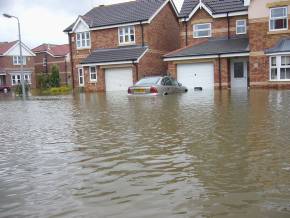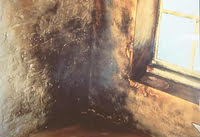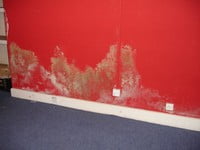Effective Restoration of Flood Damaged Buildings
Effective Restoration of Flood Damaged Buildings
Thousands of UK residents have suffered from the effects of flooding in the past few years. Hull and Gloucestershire in 2007 and Cumbria in late 2009 are two recent examples where whole communities have seen their homes and businesses devastated.
These events have highlighted the need to seek advice from contractors with specific knowledge and experience of flood remediation when dealing with properties damaged by flooding.
The recovery of flooded buildings is a complex process that will involve a number of specialists working together.
Get it wrong and six months down the line the property could develop a serious damp problem,adding to the distress of the occupants who may need to vacate their home for a second time.

This article sets out the principles that should be followed to allow buildings to be reoccupied sooner and potential future problems to be greatly reduced.
Understanding the flood
Before any investigation of the building takes place it is essential to establish the nature of the flood. Existence of sewage effluent, chemical or biological contaminants, or silts, sands and soils in the floodwater will dictate the way recovery is managed.
The height reached by the water and its rate of flow inside and around the building must also be considered as floodwater and the debris carried with it can exert extreme pressure on the building’s structure.
Understanding the building
As well as the nature of the flood, it is also necessary to understand the construction of the building.
Water affects different materials in a variety of ways. Concrete and brick are very resistant to water damage, while timber can be resistant to short-term wetting but decays if it remains wet for a long period. Dense materials retain little water but dry slowly, whereas porous materials can retain large amounts of water, but can often be dried quickly.
A history of repairs and alterations can affect the remediation of a building. For instance, the presence of a chemical damp proof course can indicate a previous problem with rising damp and, even though this may not have been affected by the flood, the presence of ground salts within the structure must be considered.
Ground salts are often hygroscopic, which means they can absorb atmospheric water. If they exist within the building at significant levels they can not only migrate with atmospheric water to affect the new finishes, but also absorb water from the air, go into solution and migrate to the surface of the wall as the water evaporates. This process can noticeably affect some modern building products, particularly those that contain gypsum.
Previous problems with dry rot in a building may also substantially increase the risk of future outbreaks if the building structure becomes wet again.
Finally, building extensions can result in voids being created between the original structure and the new addition and can often conceal original drains and service ducts, or restrict ventilation to sub-floor areas.
Diagnosis and investigation
Site investigations should begin as soon as standing water has been removed to allow the surveyor to see the building before damaged materials are stripped out.
A thorough investigation at this time is important so the surveyor can establish a base level from which the drying process can be monitored.
Monitoring should be undertaken using methods and techniques that can be repeated throughout the recovery process. The results of these tests must be recorded in a way that allows easy retrieval and interpretation during the drying stage. This will allow the surveyor to decide when a building has reached the point at which drying activities can cease and will influence the materials and techniques to be used in the restoration process.
Moisture monitoring can be undertaken using a number of devices and techniques including:
Gravimetric method - Drilled samples from the test area are placed in sealed bottles. The moisture content is then determined by over-drying in a laboratory. All materials contain some moisture when in equilibrium with the environment. This water is held within the structure or exists within soluble salts. Gravimetric testing allows the surveyor to accurately determine the total volume of water in the sample, the amount that would be present when the material is in its usually dry state (the equilibrium), and therefore the amount of free water present. It is this free water that is often introduced by flooding and that should be removed to allow the building to recover.
Chemical method - A sample of standard weight is mixed with calcium carbide powder in a pressure vessel fitted with a gauge. Moisture within the sample reacts with the calcium carbide and produces a volume of acetylene directly proportional to the level of moisture.
Conducticity meters - Moisture levels can be found by placing two probes into a wall and measuring the electrical resistance. Hand-held conductivity and capacitance moisture meters can be very useful when screening a property for damp and flood water and can be used to quickly identify areas of wood and plaster in need of further investigations. They give reliable readings in timber, but cannot be used to derive the moisture content in plaster or masonry.

Drying Buildings
Natural drying can be accelerated using dehumidification, ventilation and heat. In most circumstances a combination of all three will be used.
Speed drying - Using heaters and directed hot air. Heaters take several forms, from large diesel-powered boilers that pump heated glycol to heat exchangers, to propane fired space heaters and fan systems that run air over electric heating elements.
Dehumidificaition - Desiccant and heat exchange dehumidifiers are commonly used by flood drying companies. Desiccant dehumidifiers operate by absorbing moisture from the air that is then removed from the desiccant material as water. They are best suited for use in unheated spaces. Heat exchange dehumidifiers draw air over a cold surface where water if condensed out of the atmosphere. These are most effective where the air is warm and relative humidity can be held at a high level.
Fresh air - When conditions are right the passage of large volumes of relatively dry warm air over a damp surface will achieve very effective drying. Sometimes, at certain times of the year, the best way to achieve drying is simply to open all the doors and windows.
Different materials hold different levels of moisture in their dry state. It is not possible therefore to define a level of ‘dryness’ for a building as each will be different.
A structure is essentially ‘dry’ when it reaches a state of equilibrium with its wider environment. This cannot be expressed as a percentage of moisture content, but is derived from an understanding of the building and its constituent parts. In some cases this ‘dry’ state will be all well above what is normally considered dry in new construction, but if all the free water has been removed, the extraction of further water from the building fabric is folly.
In most cases, a surveyor does not need to decide that a building is dry, but rather that the building is in a suitable state for repair and reoccupation, without risk to the health of the occupants or further deterioration of the building and its contents.
By monitoring the drying out of the building a surveyor will be able to determine the full extent of any repairs that may be required and draw up a schedule of works to return the building to an occupiable state.
When it is considered that the drying phase is complete, further investigations should be undertaken to determine what needs to be removed and rewnewed.
Particular attention must be paid to the condition of timbers, plaster or other wall finishes and any other element of the building that may have been affected by the flood water or the drying process.
Longer term effects of flooding
Common problems reported by occupants of buildings that have undergone flood recovery include:
Condensation - It is essential to the recovery of a building that environmental controls, such as heating, ventilation, air conditioning or dehumidification, are put in place to prevent the transfer of atmospheric water to areas where it can condense and cause further damage. If condensation persists following flood recovery, detailed investigations will be required to determine the cause, which may be unrelated to the flooding.

Mould - Mould or mildew growth may be the result of an underlying problem such as trapped flood water, plumbing leaks, condensation or water ingress.
Fungal decay in timbers - Where the drying, ventilation or isolation of timbers has been inadequate, the wood will be prone to attacks from fungi. If wet or dry rot become apparent following a flood, an investigation will be necessary to gauge the extent of the outbreak and identify and eliminate any source of water.
Damp staining - Floodwater can transport minerals in solution as it moves through the building which can then be deposited in the wall and floor finishes and remain after the water evaporates. If staining is the result of hygroscopic salts, this should be investigated and contaminated materials removed or replaced.

Salt deposition - in some circumstances crystals may be deposited on the surface of new plaster. Usually theses can be removed without damage and will only be a short-term problem.
Fluctuation moisture levels - Some old brickwork can contain relatively large volumes of water which can be artificially reduced using drying apparatus. However, once the dryer has been removed the brickwork will absorb water from the atmosphere and become wet again. Allowances must be made for this when considering reinstatement methods.
Misleading moisture readings may also be obtained with electronic conductivity meters from materials that are naturally conductive.
Lamination swelling and shrinkage – Materials will naturally absorb and release water in response to fluctuating atmospheric conditions. It is essential that items such as laminate, timber strip flooring and timber wall panelling are only reinstated when the adjacent structures are thoroughly dry or can be permanently isolated from damp materials.
Code of Practice
The Property Care Association (PCA) has developed a new code of practice for the recovery of flood damaged buildings, available as a free download click here. The guide covers the assessment of flooded buildings, drying, repair considerations, examples of failures where reinstatements are not carefully considered and details on making a building more flood resilient.
The new code highlights the importance of understanding the building. It considers the need for thorough investigation at the earliest possible opportunity, and the importance of identifying pre-existing defects.
View the Code of Practice